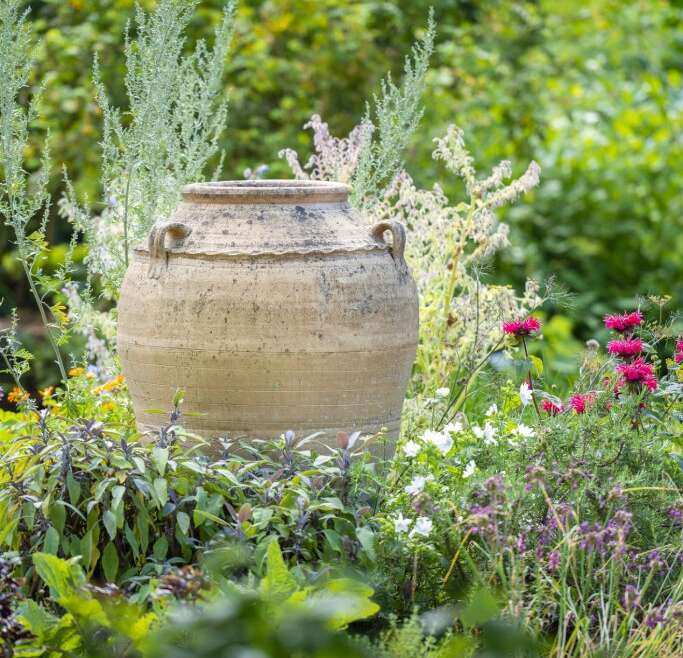Growing an herb garden in the front yard is a simple, low-cost way to ensure you always have these staples on hand. Gardening with herbs is an easy win, and fresh herbs are a staple in my cooking. They can elevate my otherwise ho-hum meal into a culinary masterpiece. A front yard herb garden is not only cost effective but allows you to know exactly how the herbs are grown. Plus they’re beautiful pollinator attractors. Read on to learn how to create your own gorgeous herb garden in your front yard.
Benefits of a Front Yard Herb Garden
There are several benefits to having a front-yard herb garden. As already mentioned, fresh herbs are the best way to add flavor and a little panache to uninspired dinners. Also, herbs can be costly, both fresh and dried. Growing your own keeps your budget in check without sacrificing flavor. And, many herbs are perennials, returning year after year.
When allowed to flower, most herb blooms attract pollinators. Welcome the bees with an abundance of oregano or lavender blooms. They will stick around and pollinate your fruit trees and veggie garden to thank you.
Many herbs also act as insect repellents, reducing the need for insecticides or other chemical controls. Herbs can also be interspersed with existing foliage, accentuating their beauty.
How to Grow an Herb Garden in Your Front Yard
You need two basic conditions to grow an herb garden in the front yard: full sun exposure (at least 6 hours per day) and well-draining soil. Otherwise, most herbs are relatively unfussy although they can be included in a formal garden.
Front Yard Herb Garden Ideas
Select a location with both of the above; sun exposure and well-draining soil. It might be part of an already landscaped area, a bare bed that needs filling, decorative containers flanking the front door, window boxes, or even a difficult area like a planting strip.
Planting strips can actually be great for growing herbs. This is an area that is often difficult to get to with proper irrigation unless you have an installed sprinkler system. Many herbs are drought- tolerant so if they don’t get daily doses of water they will still likely be fine. Plus, a bounty of herbs adds curbside appeal to your landscape.
You might however, want to put a footpath through the bed if the area is abutted by curbside parking. I know from experience how some people, surely not plant lovers, tromp through undeterred by your precious plants.
Herb plantings can be arranged in a casual manner in a raised bed or the garden proper, combined with other perennials or annuals in containers, or, ditch the turf grass and create a traditional geometric kitchen herb garden right outside your front door.
Herb Garden: Front Yard Tips
A traditional kitchen garden can be four square, a circle, or oval. It may include pathways, benches, fountains, statuary, seating and lighting. Think of a formal garden. Encompassing the entire space with a kitchen herb garden will reduce water bills, is more environmentally friendly, and requires less maintenance than a lawn.
Remember to layer your garden with the tallest at the rear of a bed or container and the shortest at the forefront. Make sure that all your herbs have similar requirements when combining them. For instance, oregano, sage, thyme and rosemary are all drought tolerant while basil, cilantro, mint and parsley need more irrigation.
On the subject of water, make sure water is accessible to the new garden. Many herbs are drought tolerant but even so they will need occasional watering. A layer of mulch can help to retain water and retard weeds around the herbs.
If you decide to allow some herbs to flower, plant enough of one variety to ensure you have plenty to harvest for your own use. Once herbs flower, their foliage becomes bitter; definitely not suited to tonight’s culinary masterpiece.
Frequently Asked Questions
What Is the Best Layout for an Herb Garden?
The best layout for an herb garden is what works for you. That said, it should be situated close to your kitchen or outdoor kitchen so it’s a simple matter to snip some fresh leaves to add to your cooking. The layout may be casual, regimented, or geometric. You can intersperse herbs with perennials or annuals, grow in container or window boxes or create a traditional kitchen garden.
What Are the Best Edible Plants for the Front Yard?
There are so many edible plants it would be difficult to pick the best one for the front yard. I love my black lace elderberry but it does need a companion to produce berries. If you’re looking for an all around useful yet ornamental plant, I’d suggest an herb. Maybe something striking like a towering bronze fennel or a “hedge” of lavender.



